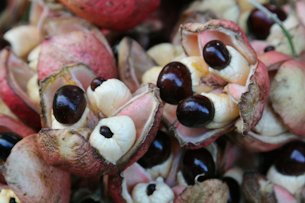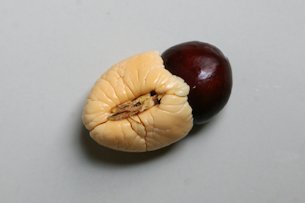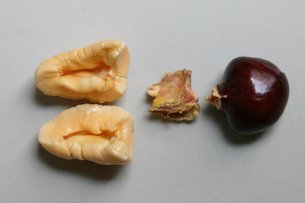Article from Eating In Translation
by Dave Cook
Jamaican produce vendor

Portions of this ripe fruit are safe to eat, but only after some careful prep work.
In 2008, ackee — a namesake ingredient in Jamaica's national
dish — was again approved for import into the United States. For most
of the previous 35 years it had been banned due to concerns that a
toxin, produced by the unripe fruit, might find its way into canned
ackee. Cans found on U.S. grocery shelves today have been processed by
companies whose food-safety systems are screened by the Food and Drug
Administration.
Without such screening, fresh Jamaican ackee
also finds its way stateside and, occasionally, makes an appearance in
West Indian markets. The specimens shown here, which I stumbled upon in
summer 2009, were brought north by a vendor who explained the procedure
for preparing fresh ackee, which is ripe (and safe for the following
steps) only when it "yawns" open to expose the pale, fleshy arils
inside. First, explained the vendor, remove the reddish or rosy outer
rind and discard it; also remove and discard all tissue that connects
the arils to the rind. From the end of each aril, pull free and discard
the single knobby seed, which is toxic even in ripe fruit; if one is
not visible, pry under or cut into the aril to locate and remove the
underdeveloped seed. Split each aril lengthwise and remove the
remaining bit of connective tissue.
The arils must then be
boiled in salted water for 10 minutes, till soft. After the water has
been discarded, the arils can be used in any recipe calling for the
canned fruit. To be sure, ackee's mild flavor and eggy texture may not
seem worth the fuss, but for the moment the point is moot. Unusually
cool weather has pushed back this year's harvest, and in 2010, fresh
Jamaican ackee may not appear in New York until late fall.
Jamaican produce vendor
Williamsbridge, Bronx
|
|


